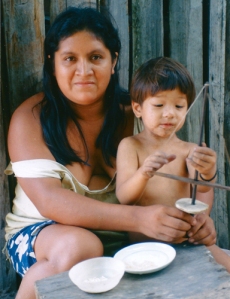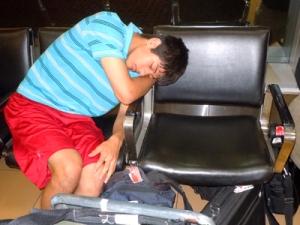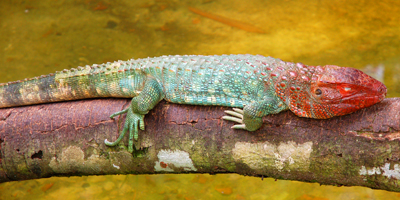June 10 – Iquitos, Peru
Our lancha (ferry) leaves for Pebas in 45 minutes so I have just enough time to write a quick blog with some highlights of the first few days of this summer’s trip to Peru.
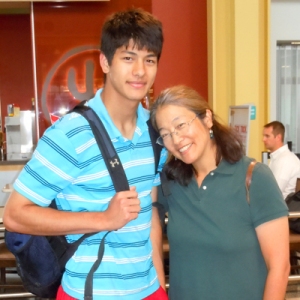
Luke and Yuri Plowden at National Airport. © Photo by Campbell Plowden/Center for Amazon Community Ecology
My wife Yuri drove our 17 year old son Luke and me from our home in State College to National Airport in Washington, DC on Saturday morning and bid us a safe and productive journey. Our daughter Marissa spent two summers with me during my first two field seasons in Peru (See Marissa’s Amazon Memories).
It was now Luke’s turn to put his many years of studying Spanish in school to use with native speakers and immerse himself in the Amazon again for the first time since he lived with us in a Tembé Indian community in Brazil when he was two years old.
Our flights to Atlanta and on to Lima were pleasantly uneventful. Arriving in Lima, we picked up our four large duffle bags – two of them were our gear, the other two were full of clothes and medical supplies donated by the Nittany Valley Regional Medical Center that we were going to donate to our partner communities with extra help from Baltimore Yearly Meeting Young Friends “Do Good” committee that promised to pay for our extra bag charges to check these. When we got to customs, we hit the button to determine if we could pass straight through or have our bags inspected by an agent. Luke hit the button and we got red so we walked around, put our bags through a scanner and I then discovered that Luke had accidentally picked up someone else’s large black duffle instead of ours! So getting the red light was a good thing, because it helped us correct this mistake quickly enough. The agent was pondering what to do with the sundry surgical supplies he found in one bag, but he passed us along after I explained that they were all going to be given to a government health clinic in Jenaro Herrera.
We then waited for another 7 hours in the Lima airport – wandering between restaurants and slumped on hard chairs until we were able to check into our flight to Iquitos.
I was hoping Luke would get a look at the jungle from the air after crossing over the Andes. We didn’t get to see the green, but he nonetheless enjoyed seeing the beautiful clouds.

Red ginger flower at La Pascana, Iquitos, Peru. © Photo by Campbell Plowden/Center for Amazon Community Ecology
We checked into a nice hostal near the Plaza de Armas in Iquitos called Casa La Pascana. It is a favorite way station for biologists, student groups and eco-folks passing through the city on a modest budget. Luke and I showered and went out for some lunch. I was very happy to reintroduce Luke to some favorite Amazon fish and fruits – paiche, don cella, assai and camu camu.
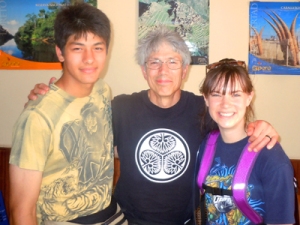
Luke and Campbell Plowden with Amrit Moore in Iquitos. © Photo by Yully Rojas/Center for Amazon Community Ecology
We boarded a motorcar and returned to the airport where we met Amrit Moore. Amrit will be our other Amazon Field Volunteer this summer. She is a fellow Quaker and an artist in a Master’s program in Museum studies at the Southern University of New Orleans who will prepare illustrations of Amazon wildlife and activities related to making crafts.
After dropping off her gear at the hostal, this intrepid duo of young Friends (Quakers) was game for immediately going out to Quistacocha – a regional park with a zoo and a swimming area. Walking around the grounds was both fun and sad. I enjoyed seeing a few of the world’s largest rodents up close, although I did have to wipe water off the front of my camera when a capybara shook her coat when she emerged from her pool in the same way a dog always shakes when coming inside after getting wet.
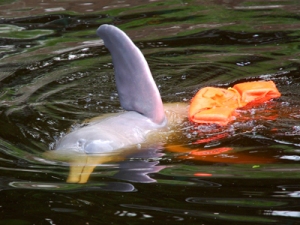
River dolphin at Quistococha zoo, Iquitos. © Photo by Campbell Plowden/Center for Amazon Community Ecology
I was also interesting to see Amazon river dolphin up close since I mostly only had fleeting glimpses of them in the Ampiyacu River, but I couldn’t help feeling this one was suffering from boredom since it kept using its extra-long thin snout to push a floating life-jacket toward a human viewer at the edge of its tank with hopes the person would toss it out again so it could retrieve it.

Spider monkeys at Quistococha zoo, Iquitos. © Photo by Campbell Plowden/Center for Amazon Community Ecology
Some spider monkeys enjoyed some sociality on a little island while “friendly” primates and otters were conscribed to cages where they begged for handouts from visitors who readily gave them bits of junk food with no regard for signs requesting that people not feed the animals. The animals that are always the hardest for me to see in these underfunded zoos are the jungle cats who perpetually pace back and forth in their small barred enclosures. At least the birds had finer meshed cages – we saw some macaws nimbly holding and knoshing on the fruit of the local aguaje palm tree.
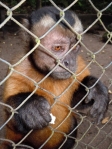
Capuchin monkey at Quistococha zoo, Iquitos. © Photo by Campbell Plowden/Center for Amazon Community Ecology
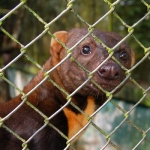
River otter in Quistococha zoo, Iquitos. © Photo by Campbell Plowden/Center for Amazon Community Ecology
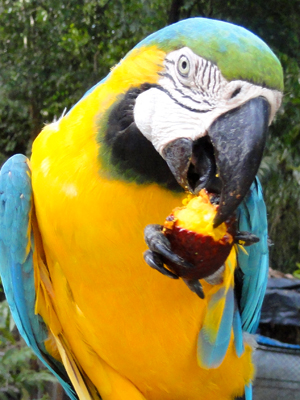
Blue and gold macaw at Quistococha zoo, Iquitos. © Photo by Amrit Moore/Center for Amazon Community Ecology
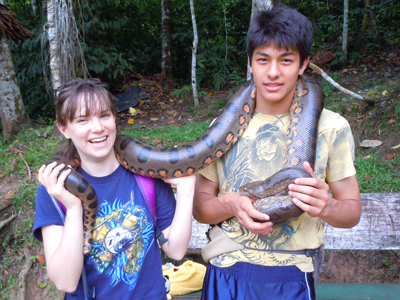
Luke Plowden & Amrit Moore with anaconda. © Photo by Campbell Plowden/Center for Amazon Community Ecology
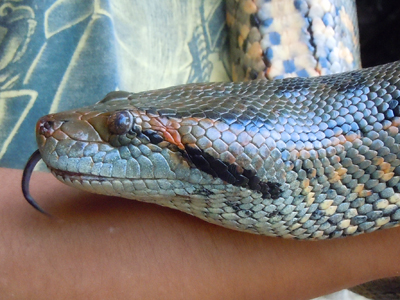
Anaconda at Quistacocha zoo, Iquitos. © Photo by Campbell Plowden/Center for Amazon Community Ecology
The aquarium building displayed a decent sample of the diverse fish and other aquatic species that are captured for the ornamental fish trade and caught for food.I did indulge in the tourist bit of paying a man a few soles for the privilege of draping his young (6 foot long) anaconda snake around the shoulders and arms of Luke and Amrit. We opted out of swimming in the lake, made a quick trip to the public restroom (be sure to have a 50 centavo coin and your own paper for such a mission), and ran to a group of casual restaurants just outside the park entrance to scope out our options for dinner as an afternoon rainstorm gathered force.
We passed up the giant “zuri”– the larva of a large palm beetle. It’s a local specialty that some people eat fresh. I was a little tempted to try it grilled, but opted to join Luke in sharing a very tasty grilled gamitana (called tambaqui in Brazil) while Amrit who is a vegetarian sampled a regional favorite called a “juane.” It’s a large pyramidal mound of mildly spiced rice steamed in a bihaw leaf. It often includes bits of chicken, but Amrit opted for one with hard-boiled egg and black olives.It was a pretty pricey motorcar ride to the park from downtown, so we opted for the budget bus on the way back to the city. It felt a bit like a flash of the past that I really only knew from TV shows based on the 1950’s since the frame of this bus was made almost entirely of wood. A helpful ticket taker let us know when we needed to weave our way from the crowded back to our stop a few blocks from the Plaza de Armas.
Luke and Amrit caught up on some sleep on Monday while I caught up with Yully about CACE affairs, shopping for our upcoming trip and meeting with two groups we may start working with – the Field Museum of Chicago and PROCREL – the regional government agency responsible for administering the regional protected areas including the Ampiyacu-Apayacu one where we work. It felt good to have these two large entities seeking to cooperate with us.
Time is short so I’ll end now. Will write next in a few weeks when we return.

